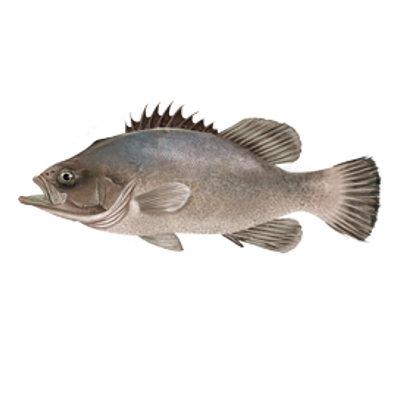

A chunky, predatory fish with a huge mouth and a grumpy expression, wreckfish, or stone bass, is a huge deep sea fish which is occasionally landed by Cornish fishermen.
It can be confused with farmed meagre (a large bass like fish) that is aquacultured in Portugal, Greece and Turkey and marketed as 'stone bass'.
This is a highly valuable, slow growing species that is vulnerable to over fishing and is classed as near threatened by ICUN. Catches to Cornish ports are low and sporadic but there is no management for this species and a lack of data making it hard to say that this species is sustainable. They are caught using baited hooks – longlines or hand lines and juveniles can be found beneath floating debris out in the open sea so is usually caught as a bonus when deep sea netters and potters chance upon them.
In 2021 only 9kg of wreckfish were landed to cornish ports (MMO data).
South West of Cornwall
Occasionally caught using baited hooks attached to bouy rope of off shore set gill nets.
Learn moreCornwall Good Seafood Guide rates fish on sustainability using a scale of 1 to 5.
1, 2 and 3 are recommended, Fish to avoid are rated 5.
We use the system devised by the Marine Conservation Society (MCS) so our scores are comparable with the scores produced by MCS for the UK and fisheries from all around the world. For more information on scoring click here.
This species is classed as data deficient by ICES. And classed as near threatened by ICUN, very little is known about this stock. Landings in Cornwall hit a large peak of 2-4 tonnes each year from 2007-2010, but soon returned to very low levels of less than half a tonne.
No minimum landing size or quota (catch limit).
Caught using baited hooks attached to the bouy ropes of offshore gill nets and occasionally also caught in set gill nets.






Cornwall Good Seafood Guide is underpinned by the Marine Conservation Society (MCS) Good Fish Guide. The first UK consumer guide to sustainable seafood. For more information visit www.fishonline.org
Cornwall Good Seafood Guide is here to help us all make sustainable seafood choices. Choices that will help us keep the oceans healthy and Cornish fishers' futures safe. This website is funded by Cornwall Wildlife Trust. If you would like to make a meaningful difference to the health of our oceans, please consider making a donation to the Cornwall Wildlife Trust Ocean Emergency fund. Your donation will help safeguard these remarkable environments, ensuring that they continue to thrive for generations to come. Together, we can be stewards of the seas and champions for a healthier, more sustainable future.